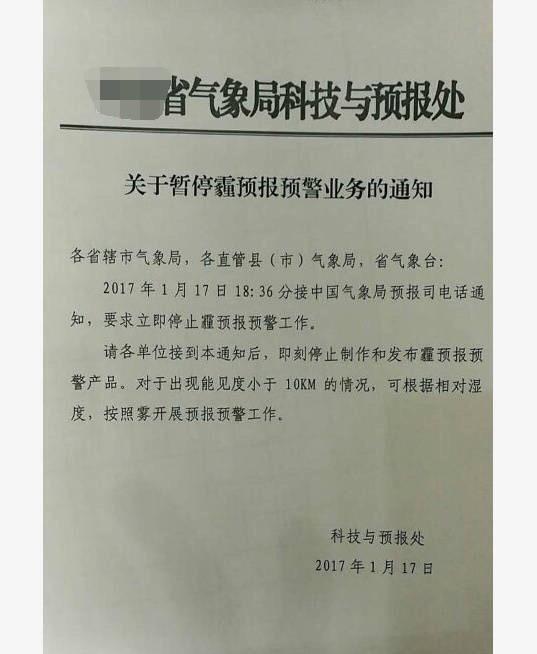On the evening of January 17, a picture of the “Notice on the suspension of forecasting and early warning services†was circulated on Weibo. The text in the picture reads: "Meteorological Bureaus of all provinces, meteorological bureaus of all counties (cities), and provincial meteorological observatories: At 18:36 on January 17, 2017, they received a telephone notice from the Forecasting Division of the China Meteorological Administration requesting an immediate halt. Forecasting and early warning work: Upon receipt of this notice, all units shall immediately cease production and issue of warning and warning products. For situations where the visibility is less than 10KM, according to the relative humidity, according to the fog to carry out forecasting and early warning work,†the influential person is “Technology and Forecasting. Department."

On the evening of the same day, Xinhua News () confirmed the authenticity of the notice from the relevant staff of the China Meteorological Administration. The staff member stated that “this notice on the suspension of the forecasting and warning business was only an internal notice and was not released to the public because the previous situation between the Bureau of Meteorology and the environmental protection department when publishing relevant information was often different. This time, a joint work mechanism will be introduced. Afterwards, it is necessary to send warnings and who will send them. There will be a meeting mechanism. Under the new mechanism, not only the Ministry of Environmental Protection and the Bureau of Meteorology, but also other relevant organizations will meet together. Then unified by a department to release. At present the details of the joint working mechanism is still seeking comments, it should be announced soon."
A number of meteorological and environmental protection system analysts said that the meteorological department no longer issued warnings and forecasts, implying that the two departments are further clarifying the division of responsibilities and avoiding the misunderstanding caused by the emergence of two types of "early warning" in public release. Song Yingjie, the host of CCTV's weather forecasting program, forwarded this message on the verified microblog and commented: "I guess it's the two departments that are studying the new rules and how to jointly issue a warning on pollution and avoid the inconsistent level of warnings. ."
In the past, people may have encountered this situation. At the same time, the Beijing Meteorological Observatory issued an orange warning, and the Beijing Emergency Management Office issued a red alert for heavy air pollution. The two agencies issued warnings about the different “colors†of hazy weather.
Why are there two color warnings on the same day? What is the difference between these two warnings?
According to China Weather Network, first of all, the issuing unit is different. The issuing unit of the Orange Warning is the Beijing Meteorological Observatory. The issuing unit of the red alert for heavy pollution is the Beijing Emergency Office.
Second, the release process is different. The orange warning is decided by the internal meeting of the Central Meteorological Observatory and issued on its own. The heavy pollution red warning is established by the Beijing Municipal Environmental Protection Bureau's Air Heavy Pollution Emergency Command Headquarters, and it is advising the Beijing Emergency Management Office to issue red warning information. The Beijing Municipal Emergency Management Office issued a red alert for heavy pollution.
The publishing standards are also different.
霾 Orange Alert Release Standard (Beijing Meteorological Observatory): It is expected that one of the following conditions may occur within the next 24 hours and will continue or live one of the following conditions and may continue:
(1) Radon with visibility less than 2000 meters and relative humidity less than 80%.
(2) Visibility is less than 2000 meters and relative humidity is greater than or equal to 80%, PM2.5 concentration is greater than 150 micrograms/cubic meter and less than or equal to 250 micrograms/cubic meter.
(3) Visibility is less than 5000 meters, PM2.5 concentration is greater than 250 micrograms/cubic meter and less than or equal to 500 micrograms/cubic meter.
Heavy Pollution Red Alert Release Standard (Beijing Emergency Response Office): Delineation of Early Warning Level According to Beijing Air Heavy Pollution Emergency Plan
(1) The air quality index (AQI) above 200 is heavy air pollution, and it is predicted that the heavy air pollution will continue for one day (24 hours) as a warning level 4 (blue);
(2) Two days (48 hours) as warning level 3 (yellow);
(3) Three consecutive days (72 hours) as warning level 3 (orange);
(4) For more than three days (72 hours or more) as early warning level (red).
In summary, Beijing Meteorological Observatory issued the main indicators of early warning reference is visibility and PM2.5 concentration. The emergency agency issued a major indicator of heavy pollution warning is AQI, it should be noted that, in addition to PM2.5, AQI (air quality index) also includes SO2, NO2, PM10, O3, CO and other five reference standards, so PM2.5 concentration does not completely control the AQI index.
Steel poles are commonly used to carry several types of electric power lines, distribution lines and lighting system. Distribution lines carry power from local substations to customers. They generally carry voltages from 4.6 to 33kV for distances up to 30 miles, and include transformers to step the voltage down from the primary voltage to the lower secondary voltage used by the customer. A service drop carries this lower voltage to the customer's premises.
Telecommunication Mast, Telecommunication Antenna Mast,Telescopic Telecommunication Mast,Signal Telecommunication Mast
Yixing Steel Pole International Trading Co., Ltd , https://www.yx-steelpole.com